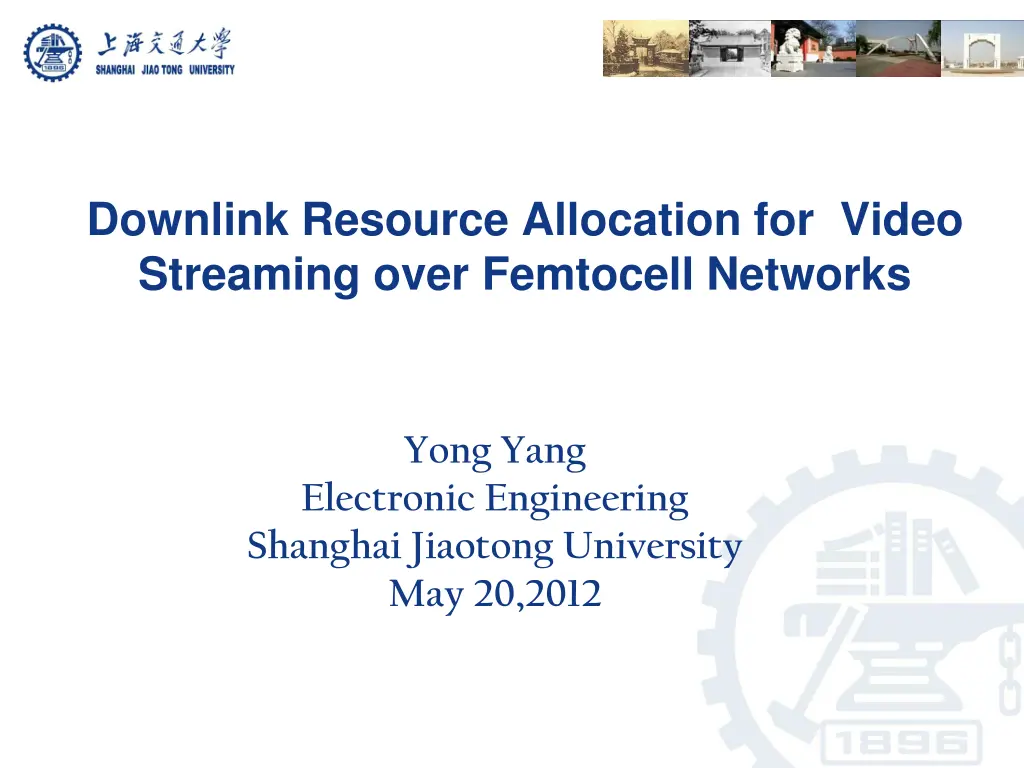
Resource Allocation for Video Streaming Over Femtocell Networks
Explore downlink resource allocation for video streaming in femtocell networks, covering background, system models, problem definitions, optimization algorithms, simulation results, and conclusions. The content delves into analyzing and modeling femtocell networks, guaranteeing SVC video streaming performance, and detailing Markovian interference models for optimal performance. Dual decomposition optimization algorithms are discussed for efficient resource allocation.
Download Presentation

Please find below an Image/Link to download the presentation.
The content on the website is provided AS IS for your information and personal use only. It may not be sold, licensed, or shared on other websites without obtaining consent from the author. If you encounter any issues during the download, it is possible that the publisher has removed the file from their server.
You are allowed to download the files provided on this website for personal or commercial use, subject to the condition that they are used lawfully. All files are the property of their respective owners.
The content on the website is provided AS IS for your information and personal use only. It may not be sold, licensed, or shared on other websites without obtaining consent from the author.
E N D
Presentation Transcript
Downlink Resource Allocation for Video Streaming over Femtocell Networks Yong Yang Electronic Engineering Shanghai Jiaotong University May 20,2012
Agenda Background System Model Problem Definition Optimization Algorithm Simulation Results Conclusions
System Model-1 How to analysis and model Femtocell Networks A single Femtocell which serves N users(secondary users) System bandwidth B Hz which is divided into M subcarriers J primary users licensed to macro cell service Orthogonal Frequency Division Multiplexing(OFDM) ??= ??|?? 0 ??,?? ?,?= 0 n ? Co-tier and Cross-tier Interference ? Pr ??,???,?> Qj,m < j,m ?=1 Discrete Time Markov Chains(DTMC) ?,m ?,m ? 1,m ? 1,m 1 ? = ? 1 ? ?
System Model-2 How to guarantee SVC video streaming performance Temporal scalability: Delay constraint Quality scalability: Peak Signal to Noise Ratio(PSNR) Q R = Qb+ R Rb = Q0+ R
Problem Definition-1 ? ? n=1 ??,? m=1 max c?,?,m??,m? Markovian interference model 2 ??,n,m??,m ? ? ? ??,?log 1 +1 ?.?. ??,mR = + ?,mlog 1 + 2t,m ? 2 ??,n,m??,m ? 1 ? ?,? 2t,m + ? 2t,m System transition ?,m ?,m ? 1,m ? 1,m 1 ? = ? 1 ? ??,?,???,?,?> Q?,j,m ? ? Pr ?=1 < ??,?,m ?,m Interference to primary users ? ? n=1 n=1 m=1 ??,n,m= 1 t,m ?t,n,m 0,1 t,n,m ??,n,m??,n,m ?? ? ??,n ?t 1,n, ??,?= EtQ ?? ??,n= Qt 1,nRt 1,? Weight based on temporal and quality
Problem Definition-2 ? ? n=1 ?? m=1 max c?,m?m? ?n,m?m2 2m +?? ? ? ?log 1 +1 ?.t. ?mR = m 2m ? ? ? Pr ?=1 ??,???,?> Qj,m < ??,m ?,m ? ? n=1 n=1 m=1 ?n,m= 1 t,m ?n,m 0,1 ?n,m?n,m ?? ? n,m ?n= ?n Jensen's inequality ?n
Optimization algorithm Dual Decomposition Inner loop Construct the Lagrange dual function Solve numerically based on fixed Lagrange factor Search one-dimensionally for best pairs Outer loop Update the Lagrange factor using the subgradient method Computational complexity: (MN)+ (log1 )
Simulation Setup-1 Parameter Value Wireless Channel Model Nakagami Fading Average SNR 20 dB Required BER 1e-3 System Bandwidth 4 MHz Number of Subchannel 128 Total Power 20 dBm Time Slots 2 Msec Primary/Secondary Users 6/4 GOP Size 8
Simulation Setup-2 Four different video sequence is used in the simulation: Sequence 1 2 3 4 Bitrate(kbps) 500 1000 1500 2000 Deadline(ms) 250 250 250 250 We define the weight with three different method: Pure-blind(W1) Deadline-blind(W2) Deadline-aware(W3)
Simulation Results-1 45 W1 W2 W3 40 35 PSNR (dB) 30 25 20 15 0 50 100 150 200 250 300 350 400 Frame Number The above figure show the urgent user in our suggested algorithm has been allocated more resource due to the higher rate and deadline requirement.
Simulation Results-2 6 4.5x 10 W1 W2 W3 4 3.5 3 Average Rate 2.5 2 1.5 1 0.5 1 1.5 2 2.5 3 3.5 4 Different Weight From the figure, we see that our proposed algorithm has actually decreased the system performance, however the deterioration is slight since users can reach the deadline as well as possible.
Simulation Results-3 Raj Jain's equation rates the fairness of a set of values where there are n users and xi is the throughput for the i-th connection. Then , we can find that our algorithm has the best fairness property. Video Quality Fairness W2 0.7030 W1 W3 0.6352 0.7399
Conclusion and Future Work A joint design approach OFDM channels with cross-tier interference Requirements of video quality and deadline Effective performance Higher average video quality at the cost of tolerable loss Better fairnessproperty Future work Multi-Femtocell Femtocell Cache Diverse multimediatraffic
Many thanks to Prof. Xinbing Wang and Xiaohua Tian Thank you very much for your comments! Yang Yong Email: sheldonyoung@126.com Department of Electronic Engineering
